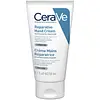What's inside
What's inside
 Key Ingredients
Key Ingredients

 Benefits
Benefits

 Concerns
Concerns

 Ingredients Side-by-side
Ingredients Side-by-side

Water
Skin ConditioningAloe Barbadensis Leaf Juice
Skin ConditioningHelianthus Annuus Seed Oil
EmollientAlcohol
AntimicrobialGlycerin
HumectantCoco-Caprylate
EmollientCetearyl Alcohol
EmollientPotassium Cetyl Phosphate
EmulsifyingButyrospermum Parkii Butter
Skin ConditioningTocopherol
AntioxidantXanthan Gum
EmulsifyingParfum
MaskingLevulinic Acid
PerfumingSodium Levulinate
Skin ConditioningCitral
PerfumingLimonene
PerfumingDimethicone 1%
EmollientWater
Skin ConditioningCyclopentasiloxane
EmollientAluminum/Magnesium Hydroxide Stearate
Emulsion StabilisingCyclohexasiloxane
EmollientNiacinamide
SmoothingSodium Chloride
MaskingPolyglyceryl-4 Isostearate
EmulsifyingCetyl PEG/PPG-10/1 Dimethicone
EmulsifyingHexyl Laurate
EmollientPhenoxyethanol
PreservativeCeramide NP
Skin ConditioningCeramide AP
Skin ConditioningCeramide EOP
Skin ConditioningCarbomer
Emulsion StabilisingMethylparaben
PreservativeSodium Lauroyl Lactylate
EmulsifyingCholesterol
EmollientPropylparaben
PreservativeHydrolyzed Hyaluronic Acid
HumectantPhytosphingosine
Skin ConditioningXanthan Gum
EmulsifyingPentaerythrityl Tetra-Di-T-Butyl Hydroxyhydrocinnamate
AntioxidantDimethicone 1%, Water, Cyclopentasiloxane, Aluminum/Magnesium Hydroxide Stearate, Cyclohexasiloxane, Niacinamide, Sodium Chloride, Polyglyceryl-4 Isostearate, Cetyl PEG/PPG-10/1 Dimethicone, Hexyl Laurate, Phenoxyethanol, Ceramide NP, Ceramide AP, Ceramide EOP, Carbomer, Methylparaben, Sodium Lauroyl Lactylate, Cholesterol, Propylparaben, Hydrolyzed Hyaluronic Acid, Phytosphingosine, Xanthan Gum, Pentaerythrityl Tetra-Di-T-Butyl Hydroxyhydrocinnamate
 Reviews
Reviews

Ingredients Explained
These ingredients are found in both products.
Ingredients higher up in an ingredient list are typically present in a larger amount.
Water. It's the most common cosmetic ingredient of all. You'll usually see it at the top of ingredient lists, meaning that it makes up the largest part of the product.
So why is it so popular? Water most often acts as a solvent - this means that it helps dissolve other ingredients into the formulation.
You'll also recognize water as that liquid we all need to stay alive. If you see this, drink a glass of water. Stay hydrated!
Learn more about WaterXanthan gum is used as a stabilizer and thickener within cosmetic products. It helps give products a sticky, thick feeling - preventing them from being too runny.
On the technical side of things, xanthan gum is a polysaccharide - a combination consisting of multiple sugar molecules bonded together.
Xanthan gum is a pretty common and great ingredient. It is a natural, non-toxic, non-irritating ingredient that is also commonly used in food products.
Learn more about Xanthan Gum